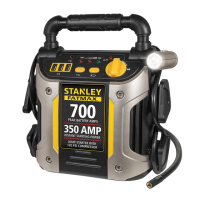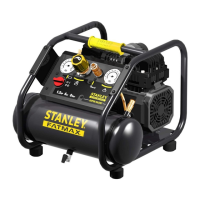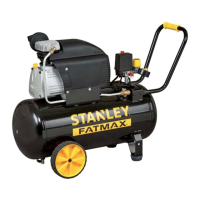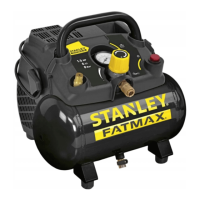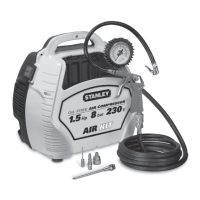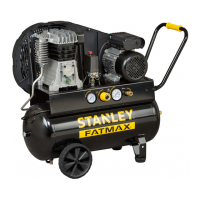17
G
B
1. SAFETY PRECAUTIONS
All users must read and fully understand all information
contained in this owner’s manual before assembling, operating,
or maintaining this air compressor.
Carefully review the following rules for safe operation and fully
understand all warnings.
An ACOUSTIC PRESSURE value of 4 m. corresponds to the
ACOUSTIC POWER value stated on the label located on the
compressor, minus 20 dB.
BEFORE USE
● The compressor must be used in a suitable environment (well
ventilated with an ambient temperature of between +5°C and
+40°C) and never in places affected by dust, acids, vapours,
explosive or flammable gases.
● Always maintain a safety distance of at least 4 meters between the
compressor and the work area.
● Any coloring of the belt guards of the compressor during painting
operations indicates that the distance is too short.
● Inserttheplugoftheelectriccable inasocketof suitableshape,
voltageandfrequencycomplyingwithcurrentregulations.
● Use extension cables with a maximum length of 5 meters and of
suitablecross-section.
● The use of extension cables of different length and also of adapters
and multiple sockets should be avoided.
● Always use the I/O switch to switch off the compressor.
● Always use the handle to move the compressor.
● Always disconnect power cord and air hose from the air compressor
before transporting.
● When operating, the compressor must be placed on a stable,
horizontal surface.
● The compressor must only and exclusively be operated in a
horizontal position.
GENERAL SAFETY INSTRUCTIONS
● Neverdirectthejetofairtowardspersons,animalsoryourbody.
(Always wear safety goggles to protectyour eyes against flying
objectsthatmaybeliftedbythejetofair).
● Neverdirectthejetofliquids sprayed by tools connected to the
compressor towards the compressor.
● Never use the appliance with bare feet or wet hands or feet.
● Never pull the power cable to disconnect the plug from the socket
or to move the compressor.
● Never leave the appliance exposed to adverse weather conditions.
● Never leave the compressor in the rain. Never use the compressor
in damp or wet conditions. Provide good lighting. Never use the
compressornearcombustibleliquidsorgases.
● Never transport the compressor with the receiver under pressure.
● Donotweldormachinethereceiver.Inthecaseoffaultsorrusting,
replace the entire receiver.
● Never allow inexpert persons to use the compressor. Keep children
and animals at a distance from the work area.
● This appliance is not intended for use by persons (including
children)withreducedphysical,sensoryormentalcapabilities,or
lackofexperienceandknowledge,unless theyhavebeengiven
supervision or instruction concerning the use of the appliance by a
person responsible for their safety.
● Children should be supervised to ensure that they do not play with
the appliance.
● Donotpositionflammableornylon/fabricobjectsclosedtoand/or
on the compressor.
● Never clean the compressor with flammable liquids or solvents.
Check that you have unplugged the compressor and clean with a
damp cloth only.
● The compressor must be used only for air compression. Do not use
the compressor for any other type of gas.
● The compressed air produced by the compressor cannot not be
used for pharmaceutical, food or medical purposes except after
particular treatments and cannot be used to fill the air bottles of
scuba divers.
● Please check that the air consumption and the maximum working
pressure of the pneumatic tool and connection pipes (with the
compressor)tobeused,arecompatiblewiththepressureseton
the pressure regulator and with the amount of air supplied by the
compressor.
● To avoid serious burns, never touch the cylinder head parts or
tubing during or immediately after operation.
OPERATION
● To avoid overheating of the electric motor, this compressor is
designed for intermittent operation(donotoperateonmorethan
a 25% duty cycle. If this air compressor pumps air more than 25%
ofone hour,thenthecompressor’scapabilityisless than the air
deliveryrequiredbythe application.Always matchtheairvolume
requirements of theattachment or accessorywith theair volume
deliveryofthecompressor).Inthecaseofoverheating,thethermal
cut-outofthemotortrips,automaticallycuttingoffthepowerwhen
the temperature is too high. The motor restarts automatically when
normal temperature conditions are restored.
● When the compressor is plugged into an electrical source and
the I/O switch is in the “I” position, this compressor will cycle
automatically.
– Never touch any moving parts.
–Keepallbodyparts,hair,clothing,andjewelryawayfrommoving
parts.
– Never operate the air compressor without all guards and shrouds
in place.
– Never stand on the compressor.
● The compressor is fitted with a safety valve that is tripped in the
case of malfunctioning of the pressure switch in order to assure
machine safety.
● The red notch on the pressure gauge refers to the maximum
operating pressure of the tank. It does not refer to the adjusted
pressure.
● Whenfittingatool,theflowofairinoutputmustbeswitchedoff.
● When using compressed air, you must know and comply with
the safety precautions to be adopted for each type of application
(inflation, pneumatic tools, painting, washing with water-based
detergentsonly,etc.).
● Never exceed the maximum allowable pressure recommended by
the manufacturer of any attachment or accessory you use with this
compressor.
● Please check that the air consumption and the maximum working
pressure of the pneumatic tool and connection pipes (with the
compressor)tobeused,arecompatiblewiththe pressure set on
the pressure regulator and with the amount of air supplied by the
compressor.
2. FEATURES (Pic. 1)
A. I/O Switch: The I/O switch is the activation mechanism that is
usedtostartandstopthecompressor.Whentheswitchis“I”
(On),themotorandpumpwillcompressairuntiltankpressure
reaches the upper limit of the factory set operating pressure.
Whentankpressurefallsbelowthefactoryset“cutin”pressure,
the compressor will again automatically start to compress air.
B. Tank Pressure Gauge: The tank pressure gauge indicates the air
pressurethatispresentinthetankinBAR(andPSI).
C. Regulated Pressure Gauge: The regulated pressure gauge
indicates the amount of pressure that is allowed into the discharge
line according to the setting of the regulator.
D. Regulator Knob: The regulator knob is used to adjust the air
pressure that is available at the discharge line. The discharge
air pressure is increased by turning the knob clockwise and
decreased by turning the knob counter clockwise.
Preserve this handbook for future reference
EN
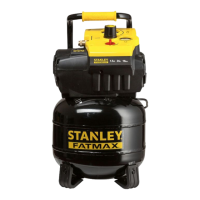
